The Glen Etive hydro proposals
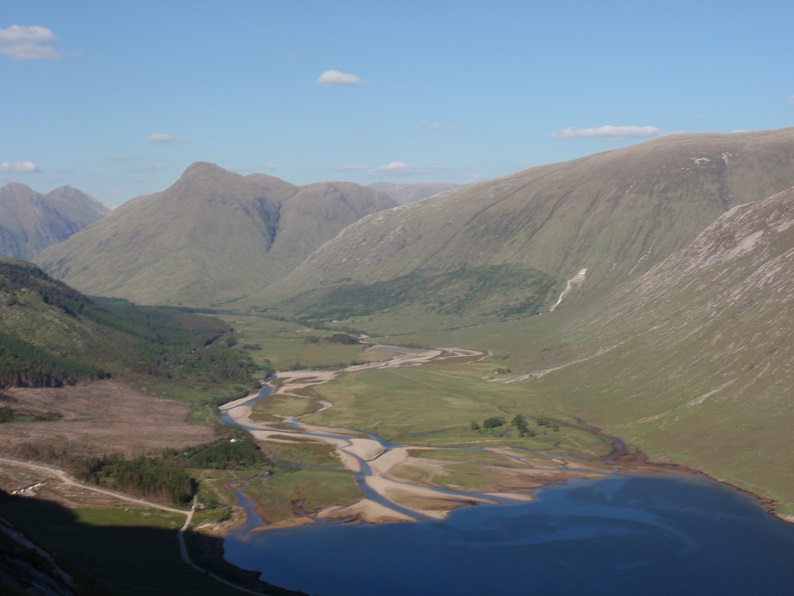
After the developments at the head of Glen Coe (see here), just when one thought it couldn’t get any worse, seven planning applications have been submitted for hydro schemes in Glen Etive on land owned by the Dalness Estate.
Each scheme has been submitted as an individual application with its own set of papers (which you can look up here using the reference numbers given below). While there are dozens of documents for each scheme, a significant number of these comprise identical information, assessments and mitigation measures which apply to all schemes, with only minor tweaks to tailor what is said to the specific proposals of an individual scheme. The number of documents is still daunting, over 100 for each scheme, and its very difficult to understand what is being proposed in each case (with Planning Statement, Support Statements and Environmental Impact Assessments covering much of the same ground). I have therefore extracted some information and presented in the table below as a quick reference point and to make it easier to appreciate the cumulative impact of the schemes as a whole:
| Scheme | Planning Reference | Size | Permanent new Access Track | Width main intake & wing wall | Other intakes & wing wall | Other comments |
| Allt Fhaolain | 18/02740 | 586kw | 2.7km | 27m | 1 x 2.9m | Most objections Grampian Club Hut |
| Allt Charnan | 18/02738 | 1035kw | 1.7km | 18.5m | 1 x c18.5m | In area conifer forest |
| Allt na Gaoirean | 18/03024 | 980kw | 285m + 175m | 16.5m | 1 x ?m | Uses 2.5km existing forest track |
| Allt Mheuran | 18/02741 | 1540kw | 1.8km | 15m | 1 x 25m | Wild Land Area |
| Allt Ceitlein | 18/02739 | 810kw | 1.7km | 20.7m | 2 x 2.7m | Wild Land Area |
| Allt a Chaorainn | 18/02742 | 1640kw | Short track to powerhouse | 21m | 1 x 21 m | WLA 1.6km construction track to be reinstated to stalkers track |
| Allt a Bhiorain | 18/03026 | 715kw | 90m | 20m | 1 x 2.9m | Uses forestry access. Lower section in felled area |
NB each scheme has a separate powerhouse
Thanks to the lead given by the Grampian Mountaineering Club (see here), whose hut at Inbhirfhaolain is very popular, and Mountaineering Scotland (see here) there has been significant opposition to the developments from the public – the first time this has happened with run of river hydro schemes in Scotland (the Glen Affric hydro schemes, for example, were approved without any objections). While both the Grampian Club and Mountaineering Scotland have objected to a number of the schemes, the focus of other objections has been on the Allt Fhaolain scheme where there are specific issue about the guarantee of future water supplies to the hut and the impact of the noise from the powerhouse on those staying there. This has resulted in over 30 objections to the Allt Fhaolain scheme compared to 6 for the Allt Mheuran, for example.
My view is that there are serious concerns about ALL the schemes and their cumulative impact and will explain why in the post. While it will be interesting to see how the planners and the Council respond to the objections, without far more and without wider political pressure, I believe Highland Council will ultimately discount the objections as they did with the Kingshouse and approve the scheme. This is because landscape, wild land and everything else both outdoor recreationists and tourists find special about Scotland’s countryside, comes a poor second to development in our planning system.
The visual impact of the hydro schemes
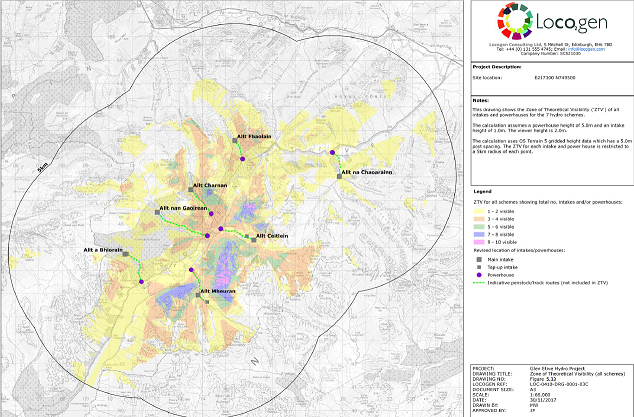
All of this affected area lies within the Ben Nevis and Glen Coe National Scenic Area.
The photo diagram below, besides illustrating the extent of the impacts, illustrates a number of serious defects in the visual impact assessment:
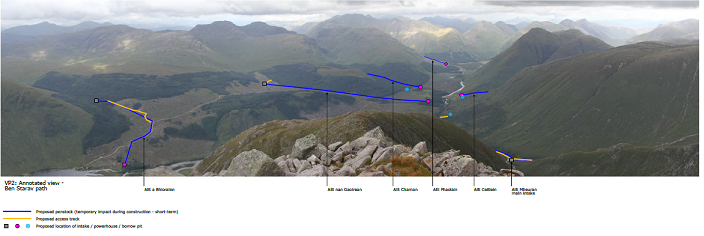
The viewpoint seems chosen to conceal most of the nearest hydro scheme, the Allt Mheuran (bottom right) and fails to marks the line of all the access tracks (which should have been highlighted in yellow). The developers landscape assessment concludes that after the construction phase there will be no long-term significant landscape impacts.
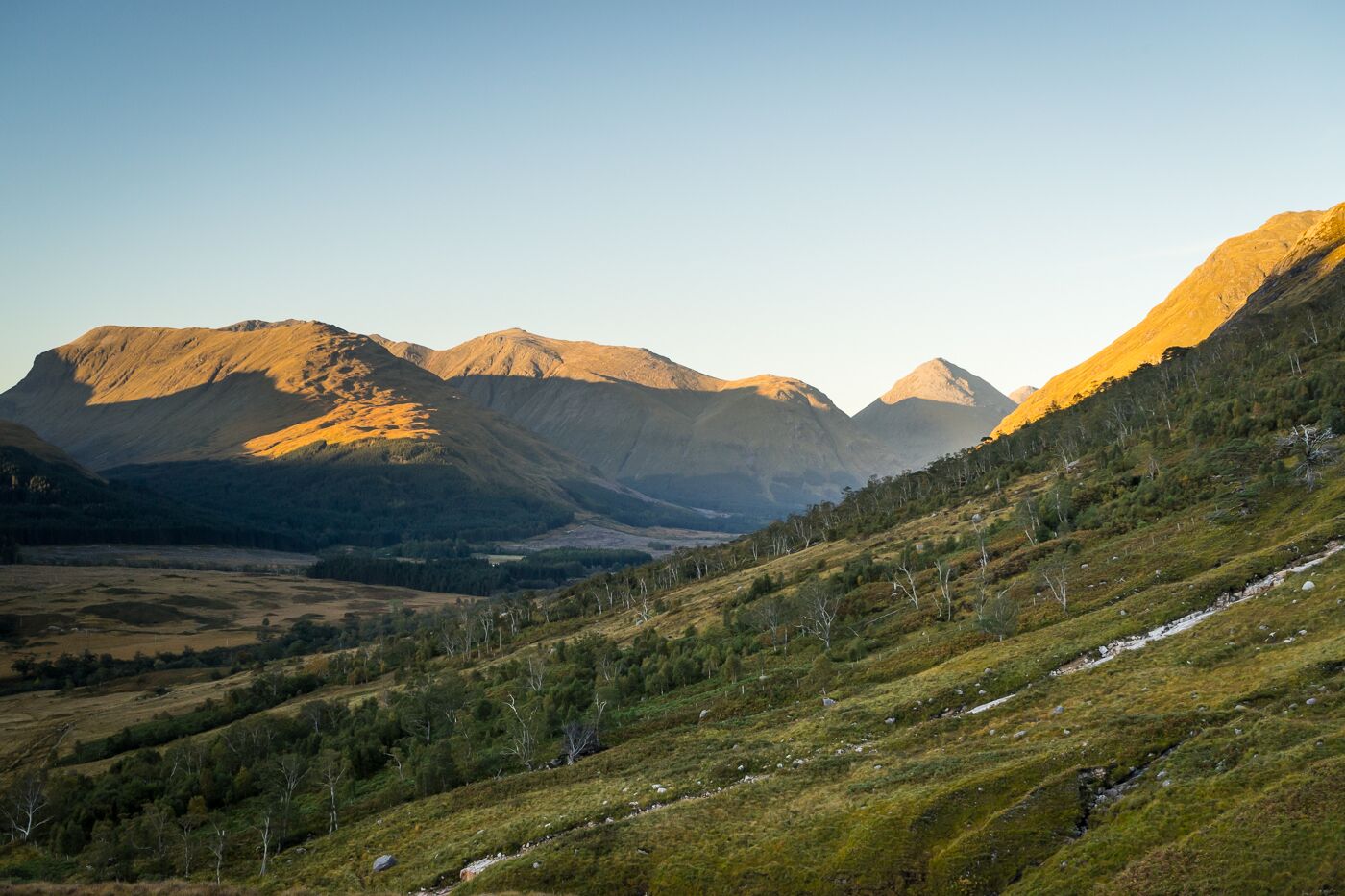
So, first thing to state clearly is that there are going to be 8.2 km of permanent new access track – yes, that’s five miles of new track in a relatively small area famed for its landscape importance.

There is no proper attempt to evaluate the landscape impact of the construction of permanent tracks into these side glens. In only one scheme, the Allt Chaorainn, is it proposed to restore the construction track and I cannot find any explanation why.
The answer may be linked to the fact that,after pre-application discussions, Dickins Hydro Resources Ltd, the applicant, decided not to go ahead with schemes in the two burns which run west into the Etive from either side of Creise, the Allt Fionn Ghlinne and the Allt Cam Ghlinne. Perhaps the planners advised that yet more development close to the entrance to Glen Coe (see my last post) would be unacceptable? If so, perhaps the developer concluded that they would consider a scheme on the Allt Chaorainn if the track was restored? Whatever the explanation, if the construction track can be restored for one scheme it could be restored for all.
To complicate matters as far as I can find the application also fails to state explicity that the estate has already constructed tracks up some of the side glens, although evidence for this and their impact can be found in the planning documents (see below). Again, as far as I have been able to ascertain, these have been constructed without planning permission to which the estate might respond by saying they are for agricultural purposes and therefore permitted developments. The planning applications, if approved, would in effect consolidate these tracks and make them bigger.
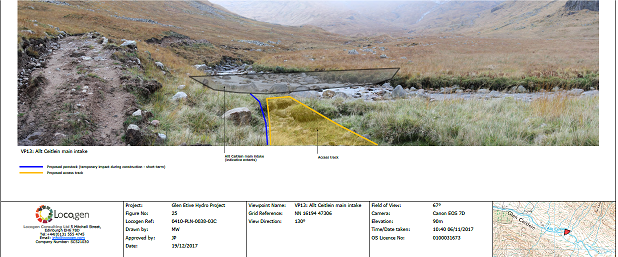
The second major landscape issue are the intakes.

ALL of the schemes have two intakes (table above) and one has three. Many of these are large, with six being over 20m broad if their wing walls are included. Together with their height, what that means is an area of water is going to be impounded behind the dams although how much is NOT made clear. Intake pools and infrastructure will therefore have a significant impact on landscape even if all the hydro tracks were restored. While described as run of river hydro schemes actually most appear more than that.
The third landscape issue is the applications fail to assess how the construction of 7 new buildings to house the turbines, a significant increase for a barely inhabited glen, will impact on its character. Its important to note here that one of the most valued scenic aspects of the Glen is the River Etive and all seven buildings will be located close to the river.
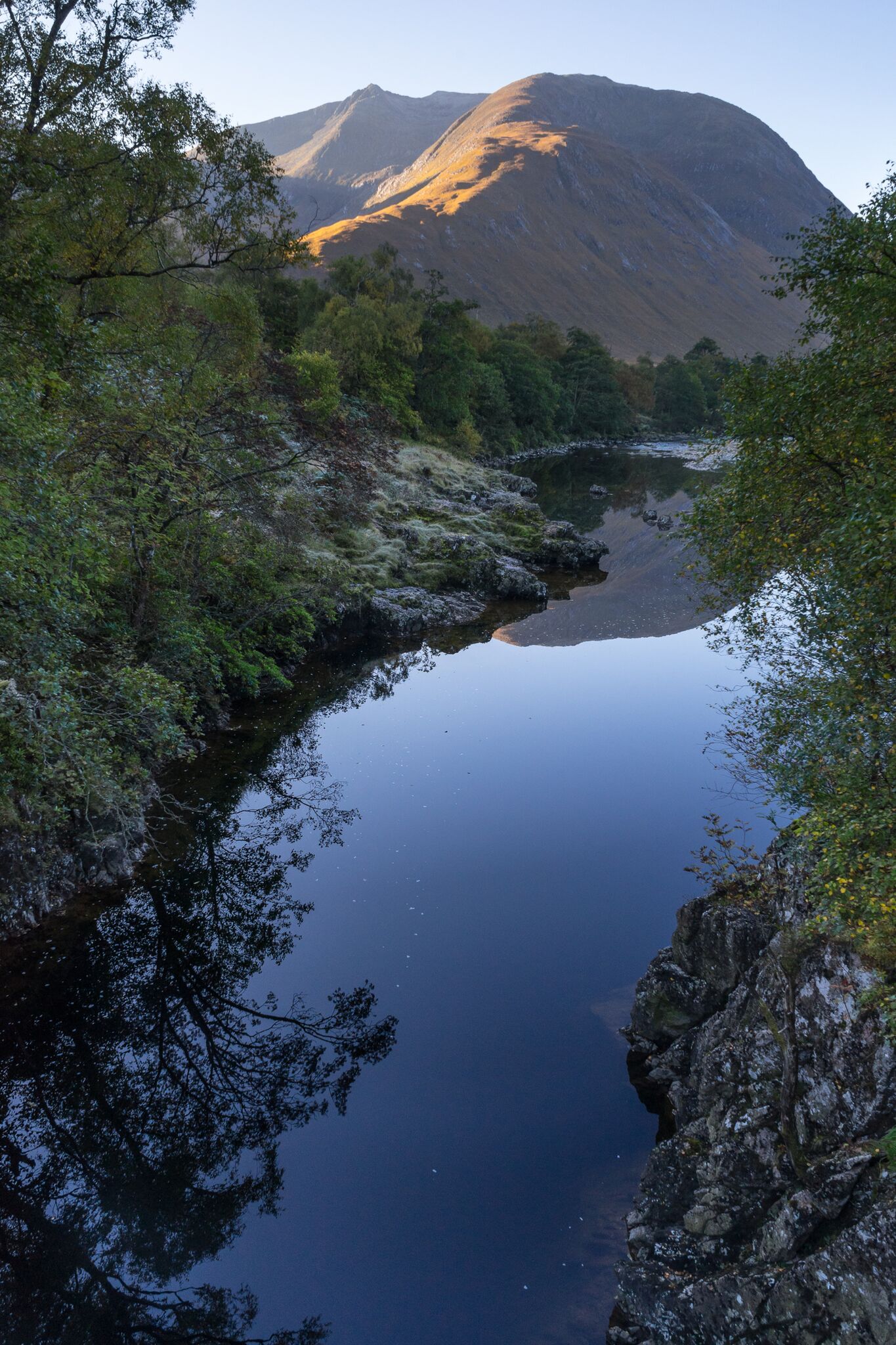
“Despite the legitimate concerns about littering, it’s a magical place for car camping for those newer to the outdoors, and most leave it as they found it” (David Lintern)
Glen Etive is also a magical place for wild swimming, canoeing or just wandering along the river..
Fourth, I can find no mention in any of the applications about how these power stations will be connected to the grid although there is a reference to a new underground powerline being dug to connect the schemes to the grid. There appears to be no assessment of the impact of this but it would add considerably to the area of disturbed ground.
And, fifth, related to all these proposed works, the application basically asserts that all the restoration work will be successful. With few firm proposals about either construction or restoration – for example all the applications state the exact lines of tracks and pipelines are still to be determined – this is impossible to assess. The experience of hydro schemes elsewhere suggests without very full and detailed specifications and a high level of supervision this is unliikely to happen.
The Developer has marketed these schemes to Highland Council as though they were selling a house:
“The Development benefits from a high landscape and scenic quality within Glen Etive providing opportunities for fishing and canoeing/kayaking and particularly during summer months, it is popular with scenic car journeys, informal camping and walking”.
This misses the point completely. Its the impact of the development on this landscape which is what matters not whether the development is in a beautiful setting and its important to consider the impacts of the different elements of the schemes as a whole. Unfortunately, SNH, as they did at the Kingshouse and White Corries ski track, claim that the integrity of the National Scenic Area won’t be affected by the developments. I could not refute this any better than John Mackay (who used to work for SNH) and who has objected to each and every application:

The hydro schemes and the Etive Mountains Wild Land Area
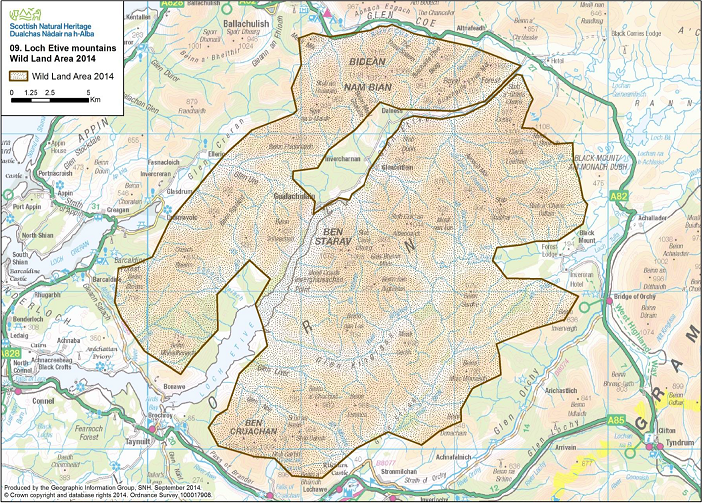
While the road down Glen Etive, the buildings and the intensive forestry plantations and the River Etive itself are excluded from the Wild Land Area this does not mean they are not valuable in wild land terms. Indeed its the wild scenery by the river, and the wild feel of the river, that attracts many people to Glen Etive.
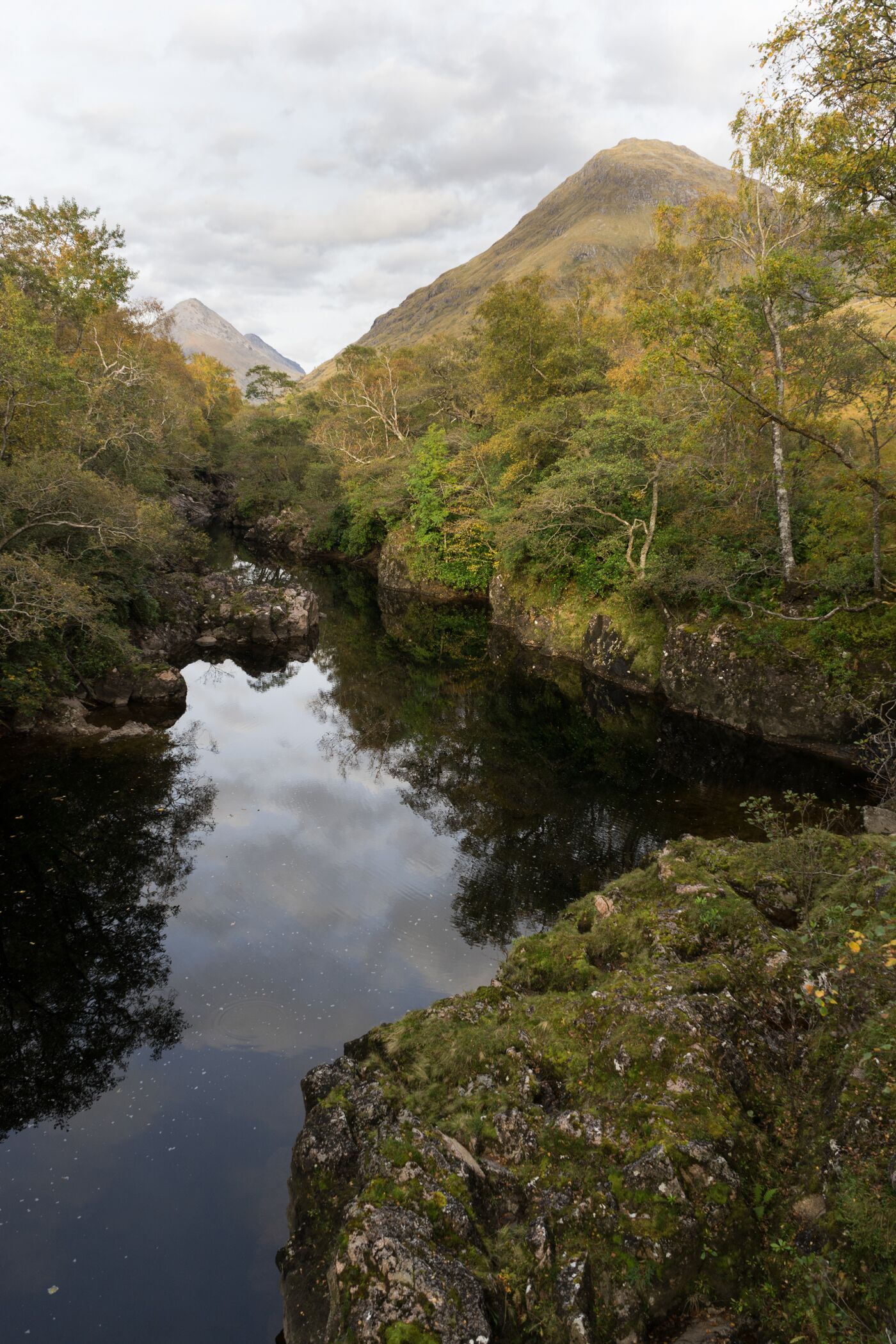
While SNH’s Wild Land Assessment (see here) says nothing about the River Etive itself, it does recognise that the feeling of wildness that people get from the floor of the glen (and the excluded area) is of value:
Many people view the WLA from outside its edges, including along the A82 over Rannoch Moor and through Glen Coe, the A85 around Loch Awe, and the roads through Glen Creran and Glen Etive. From these, although views into the interior are limited due to the screening effect of the adjacent slopes, it is nonetheless possible to experience some of the wild land qualities of the area, including a perception of naturalness and ruggedness.
In Glen Etive this is felt even more than in the other glens mentioned here, in no small part because the road is so small and there is relatively little traffic.
The distribution of human artefacts and contemporary land use within this WLA does not follow the conventional pattern of being more prolific around the margins and leading to a gradually more remote interior with fewer human elements. In contrast, there is a strong presence of human elements within the centre of this WLA (albeit outside the boundary, as an exclusion around Glen Etive) and within some interior glens that diminish the sense of remoteness. The effects of these human elements are amplified where they link across the area between the interior and the margins, for example by vehicular tracks or power lines.
The Wild Land Assessment And hints at the potential to improve the landscape by reducing the adverse impacts of industrial forestry in the glen:
Although lying outside the WLA boundary (within an exclusion in the centre), Glenetive Forest encroaches upon the wild land qualities within the surrounding area. This is partly due to its central location surrounded by mountains, as well as its very large size and extension onto elevated slopes, prominent high-level haul road and frequent forestry activities, and incongruity of shape, colour and texture.
While four of the schemes are partially in plantation forestry and make some use of existing forest tracks, there is nothing in the applications I can find to suggest that these forests will be restructured or that woodland regeneration will be promoted which would allow the hydro infrastructure eventually to become hidden by native woodland. And the powerhouses as well as other parts of these schemes will clearly be visible from the Wild Land Area.
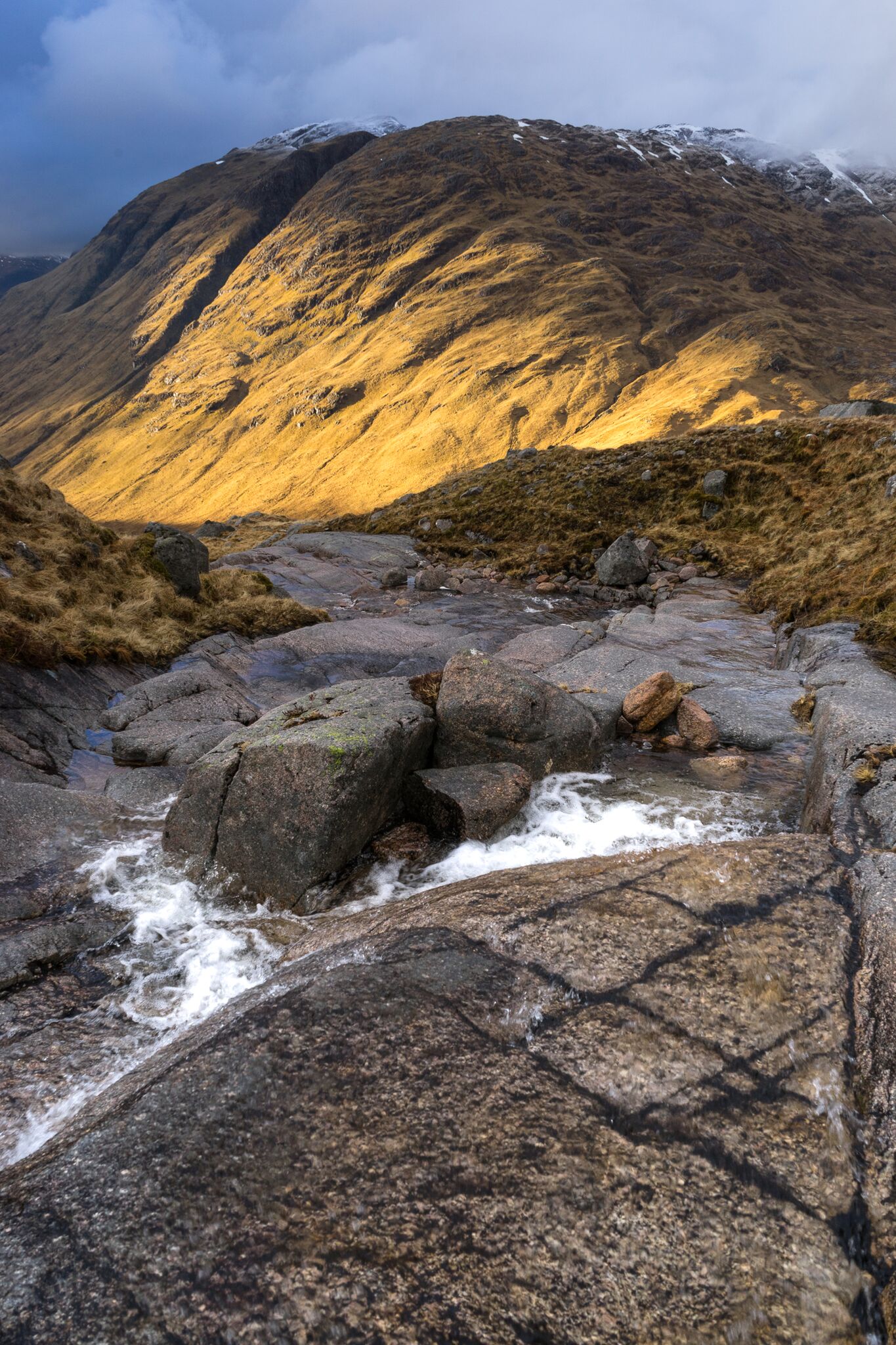
The recreational experience – noise
One of the pleasures of Glen Etive is its quiet and does not suffer from the incessant traffic noise of Glen Coe. That quietness is a pleasure, adds to the wild land experience and indeed allows people people to listen to nature. If you have not stood by an operational hydro you should do so as they are noisy. Seven power houses, seven sources of incessant noise as long a there is water in the burns. The Grampian club have addressed the issue well in their objection (link above).
The recreational experience – water
The River Etive is very popular for both swimming and canoeing and, because the hydro schemes are in side burns and deposit water back into the Etive, the volume of water there will not be affected. Its a different matter for the side burns and the Allt Chaorainn is one of the best rivers for serious kayakers in Scotland.
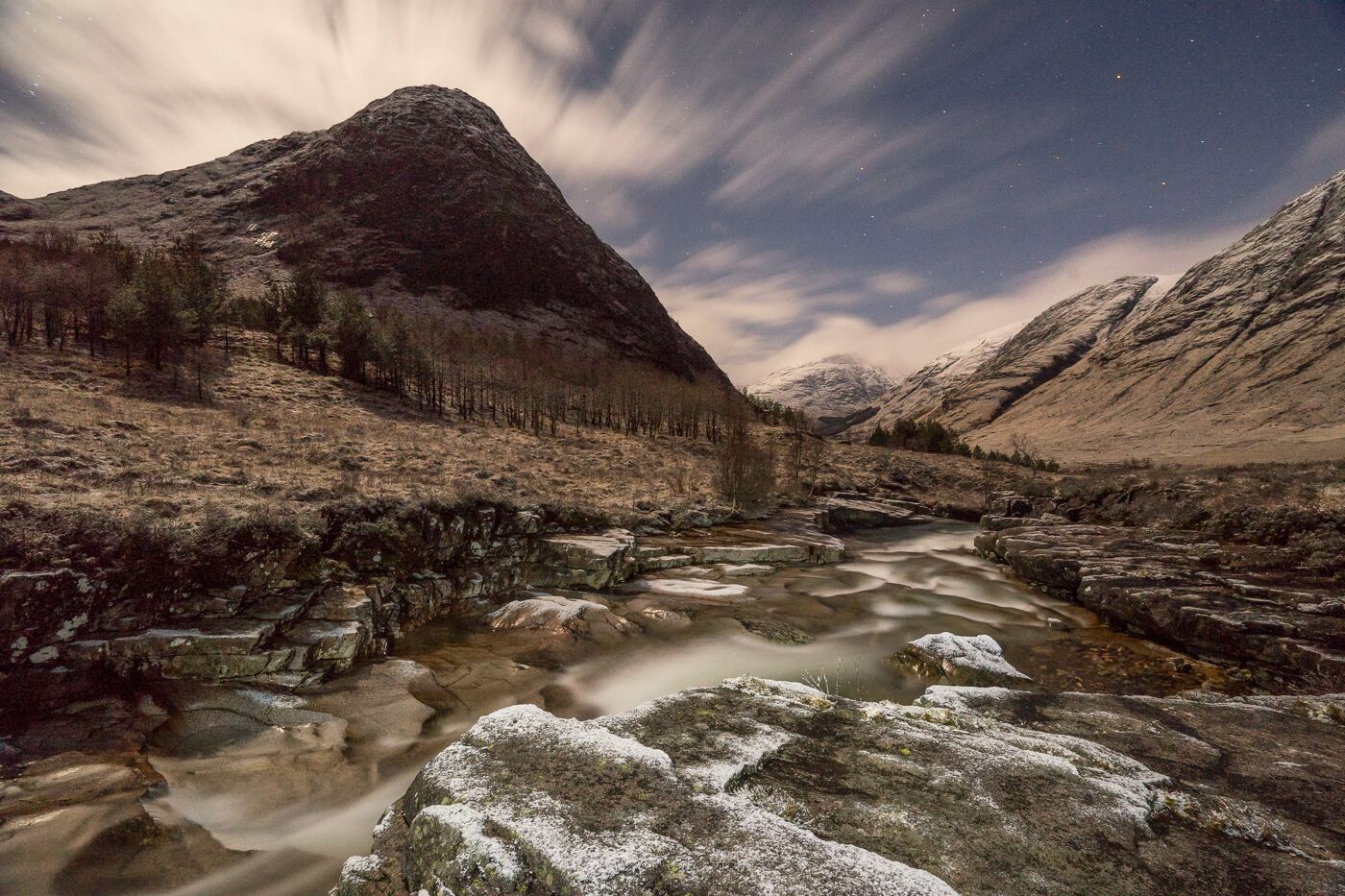
While the developer engaged with with the Scottish Canoe Association none of the mitigation measures the SCA thought they had agreed were included in the application and the SCA has therefore objected. Their objection, which includes a detailed assessment of the paddling on the Etive tributaries, is well worth reading and can be obtained via planning portal (its too big to include here)
The cultural impact
John Murray in his wonderful book, the Literature of the Gaelic Landscape, devotes a couple of pages to Duncan Ban Macintyre’s waulking song set in lower Glen Etive, the Song of the Ewe. This is both a description of making cloth, which starts with the famous Gaelic poet who was once a gamekeeper at Dalness, going out to beg for wool from his neighbours, but is also a songline to the people and places in the lower Glen – just where the hydros will be concentrated. Both Glen Ceitlein and Inbhir Charnan are mentioned by name.
Murray’s book also describes the links between Glen Etive and Deirdre of the Sorrows, one of the most well known and tragic heroines of early Gaelic literature.
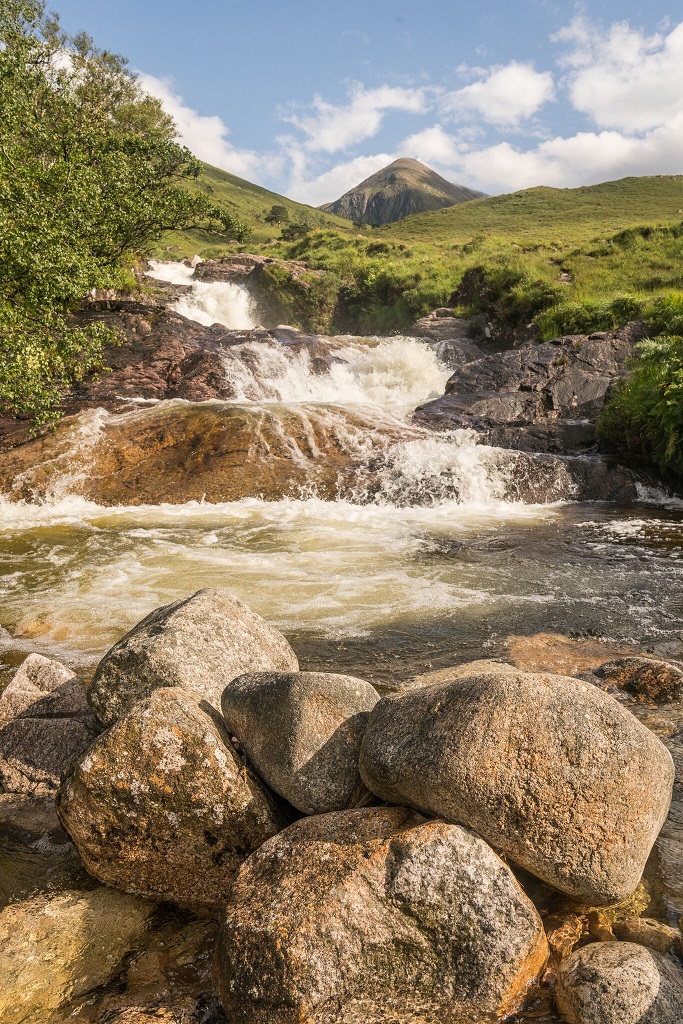
The Robber’s waterfall on the Allt Mheuran gets its names because bandits used to ambush drovers from up there. Etive was important for droving and Scotways record the route along Loch Etive as one of the oldest in the highlands. Glen Ceitlein has a number of shielings.
What can be done to stop the proposed hydro schemes in Glen Etive
I have tried to describe here why Glen Etive is such a special place and how the hydro schemes threaten to destroy that. In my view they should be rejected in their entirety. No ifs and buts, its time to say no. Whether you agree with this position or are just concerned with some of the schemes, here are some things that you can do:
- Object to ALL the applications you think are wrong. You can do this by first finding the application on the planning portal (see here) using the reference number in the table above and then using the comments button. If you have already objected to the Allt Fhaolain application please consider objecting to other schemes too.
- If you are a paddler, support the SCA and add your objection to theirs, particularly for the Allt a Chaorainn scheme
- If you live in Highland Council area contact your local councillors and ask them to ensure the Council puts in place policies that will protect special places like Glen Coe and Glen Etive from hydro developments and, if you live in the South Area, whose councillors should decide the application, ask them to oppose the development.
- Contact your local MSP and explain your concerns about the proposed developments in Glen Etive: sk them to support and ;promote amendments to the Planning Bill which would offer greater legal protection to the landscape in places like Glen Coe and Glen Etive.
- In any lobbying point out the vital importance that the landscape, including the history it tells, has for tourism and the rural economy.

These 7 hydro schemes proposed for Glen Etive would have a disastrous impact on the landscape and its public enjoyment. The comprehensive objection to all these schemes submitted by John Mackay, a former senior staff member of Scottish Natural Heritage, is exemplary. By contrast, the comments by present day SNH staff are pathetically amateurish. If this is the quality of advice currently emerging from SNH we can be confident that no National Scenic Area and no Wild Land Area is safe from massive development impacts. The Scottish Government needs a complete overhaul of its principal advisers on environmental and outdoor recreation matters so that public confidence in this agency can be restored.
I am constantly astonished by the short-sightedness of objections made against renewable energy proposals on “environmental” grounds. Climate change threatens environmental damage many orders of magnitude greater than the relatively minor impacts of well-designed schemes.
It’s like refusing to let the fire brigade onto your property as your house burns down because you’re afraid they might trample on the flower beds.
The arguments presented aren’t even about concrete environmental harm (ie specific impacts on named species, loss of habitat, etc) but rather a highly subjective impression of visual aesthetics.
“We could have saved the world but we didn’t want to spoil the view”.
I love to wander around in Scotland’s wild places. If it wasn’t for the looming catastrophe of climate change I’d be right behind you. But that is not the world we have to live in. Climate change threatens a global mass extinction. Depending on the emissions scenario, we might lose 1/4 of the Earth’s species. Half of US bird species are at risk according to the Audubon society. The UK cold lose much of its peatlands.
Biodiversity will recover, of course but it will take many millions of years to do so (Kirchner & Weil 2000) – much longer than the expected lifetime of a large mammal like homo sapiens. For all of the rest of human history those who come after us will never know the same rich diversity of life which we enjoy today. There won’t be a damn thing they can do about it. It takes a very long time for new species to co-evolve in the complex webs of dependency found in a rich, mature ecosystem.
This could be the greatest act of vandalism in human history. To put spoiled views before genuine environmental harm on such a cataclysmic scale would be the most awful, narrow-minded narcissism. It’s reasonable to require developments to be significant (ie provide useful amounts of low-carbon power) and to be carefully designed to minimise impacts but it is not reasonable to expect them to be invisible.
Noel,
You say your are amazed by the shortsightedness of objections against renewable energy developments – if you can show me other run of river hydro schemes where there have been objections please say (I have looked at the badly designed schemes that have trashed Affric, including bits of Caledonian forest and the peat you are concerned about, Torridon etc and there has not been one objection). The only objections I know of up till now was to the new scheme at Ben More at Crianlarich last year and that was to a permanent track not the scheme itself.
If I might say I am constantly amazed by the blindness of the people who support a completely unregulated market in renewables and see the market as a means of combating climate change – the whole run of river hydro market is completely irrational, it depends entirely on what landowners want to put in where, there is no plan of where schemes might best be located and certainly very little good design or planning enforcement. In most cases I think the schemes could be made acceptable if there was no track and better design (I am a supporter of renewables)but my argument here is that there are some places that are so special that run of river schemes should not be allowed. I assume from what you say about renewables coming before anything else and that the value of scenery is totally subjective that you would want to build hydro schemes throughout Glen Coe – is that your view? And do you think there should be windfarms all over Rannoch Moor?
If so, I think you are making a terrible mistake. All the research shows people value unspoilt scenery and wild land – it gives people an idea about a world not dominated by humans – but if you allow all of that to be developed why then care about the environmental at all? In fact many of us who care about wild land see that wild land as the primary areas where we can restore the fully functioning ecosystems you care so much about.
I also think your argument that climate change is the greatest threat to biodversity is highly debateable. While climate change is a significant threat (coral reefs, melting of the Arctic) the reason for the mass extinction which is going on at present is due to direct human development and intervention (cutting down of forests for agriculture, the intensification of agriculture, fishing out of our seas etc).
There are many environmental problems as well as climate change – sure – but these are regional issues with various, specific causes. Impacts are limited in scope. Local action is required to solve them. Recovery times can be very rapid (except for species loss). A bulldozed track, for example, will be reclaimed naturally in a few centuries even without any intervention.
Climate change means that practically every habitat on Earth is going to experience changes – sometimes drastic, qualitative change. This will render many regional conservation efforts redundant. It’s like trying to hit a moving target. Saving a forest from loggers won’t help if a changing climate transitions the whole area from forest to savanna. An environmental catastrophe on a global scale must be the first priority.
Apart from conservation issues, the biggest impact on our own species will be the struggle to grow food in these changed habitats. Food prices will rise everywhere. Vulnerable, poorer countries will experience more frequent famines with associated increases in mass migration and armed conflict. Even some richer countries could get squeezed pretty hard.
I’d find it difficult to place arguments based on visual aesthetics at the same level. Even a certain amount of concrete, environmental harm is acceptable given the scale of climate impacts – the greatest challenge we’ve ever faced as a species.
I say that as someone who loves Scotland’s wild places – but I also believe that we can’t understand anything properly without context. Mass extinction and impacts on global food supply create a pretty grave context which demands we make small sacrifices now to avoid worse outcomes in future.
It shouldn’t be a free-for-all. New developments should be required to take all reasonable steps to minimise impacts. Although we can’t exclude all “wild” land areas it would be reasonable to try to prioritise them. Then we work down the list as far as we have to to build what we need.
I headed up Strathdearn and over the Monadhliath to Fort Augustus last October. Part of me was sad to see the turbines going up east of the Glen Doe dam but I know we need them. In a couple of centuries they’ll be gone again as wind moves offshore and new energy technologies are developed (fusion?). I think that’s a small price to pay considering the alternative.
So Noel, what Wild Land Areas and National Scenic Areas should be used for hydro developments and which not? To repeat question, do you think hydro schemes should be built over Glen Coe and wind turbines put all over Rannoch Moor? If not, where would you draw the line and how does Etive fit into your idea of where priorities should be? There is no national planning and hydro schemes produce a small amount of electricity paid for which a huge amount of money is paid for by the public most of which then ends up in the hands of absentee landowners and the city. Add to that the cost in carbon of constructing these schemes – has anyone worked out the amount of carbon which is taken out of the earth to manufacture the pipes? – and there are far far better ways this money could be spent to reduce our carbon imprint. Run of river hydro has only a tiny role in combatting global warming and as you say will soon be overtaken by new technologies – where are the clean up bonds? – but you are trying to shoot down people who are arguing that some areas should be kept free of such developments to remind us both of worlds that have been and how the world could be. In taking such a stance the proponents of renewables at any cost have alienated people who should be the greatest supporters in the fight against global warming and has had practical consequences, the departure of John Muir Trust and Mountaineering Scotland from Scottish Environment Link being a good illustration of this.
Noel, while you are right, global warming is the biggest single threat to humanity (barring a large asteroid) but it’s not an ‘either or’. We must reduce carbon use but not at the expense of some other things we value. It is reckoned that the proposed Etive hydro schemes would generate 1/10th of a single (yes, single) off shore turbine. What makes me despair is that we are continuing to waste enormous amounts of the energy. I suspect that over a one hundred year life span, the Etive hydros would produce far less energy than would be saved if all of us in the UK got a grip and, for one week only, turned unnecessary lights off, turned down the heating, took public transport and stopped doing stupid things like flying to Eastern Europe for stag parties which could be held in the pub next door.
Energy is far too cheap, that’s why we continue to waste it (yes, there is real fuel poverty but this should be addressed through the tax and benefits system).
George
PS I have solar panels and shares in a company which operates wind and hydro projects but I want Scotland’s finest landscapes to remain un-industrialised.
This has to stop. Glen Etive is a beautiful and remote area which should be at the forefront of protection of the environment. In our home we conserve energy and grow our own food. Wastefulness of power and over population have to be highlighted and addressed. We have one planet…let’s all look after it.
Renewable energy started out as a good idea that no-one could object to, but it has turned into a marauding dragon bent on destroying what it was supposed to save. Anyone on the way to compleating their Munros (or Corbetts) gets around a fair bit in the Highlands and is better placed than most to witness at first hand the extent of the devastation wrought by intrusive, ill-sited RoR schemes in glens and corries and the unstoppable march of wind turbines across the uplands. As a Scot with a strong sense of place, I am horrified by what I see happening. I would much rather try to reduce my own carbon footprint than allow developers and landowners to rip up my natural heritage for financial gain. Subsidies, not concern for the planet, are the main driver behind the current goldrush, with many hydro schemes generating negligible amounts of electricity in return for a huge amount of landscape and environmental damage. A visit to Glen Affric, Wester Glenquoich, Heights of Kinlochewe, Bridge of Grudie and Glen Falloch, to name just a few of the many special places desecrated in the name of renewable energy, should give the doubting food for thought. Must Glen Etive now be added to that roll call? I used to live in Scotland, a place of much natural beauty; now I live in a sterile renewable energy park. Oh well, at least with all that handy electricity I’ll be able to leave the lights on all night and keep my many gadgets on permanant standby. Just as well, really, because the way things are going in the Great Outdoors I’ll soon be too disgusted to leave the house.
Few facts,
1. Glen Etive is not remote
2. Glen Etive is not unspoiled
3. Glen Etive has a community, no one is asking what they would like
4. Glen Etive school use to have 22 children
5. Glen Etive is fast becoming a play ground for the few, if not already
Jane, how can you claim that renewable energy started out as a good idea? If people had worked out at the start just how much infrastructure would be needed I can’t believe that anyone would have thought it was justified. To give an example the U.K. gets aprox. 10% of it’s electricity from wind turbines (couldn’t find info just for Scotland).The wind industry will claim it’s 30%, but this refers to installed capacity not actual output, obviously when there is no wind we get no electricity. Given that electricity accounts for between a quarter and a third of our energy use, (the other main uses being transport, domestic gas use and industrial use) then simple maths shows that we get about 3% of our energy from renewables, 5% if you include hydro and solar. If anyone had said at the start that we would need at least 20 times as much infrastructure as we currently have plus as yet non existent storage technology no one in their right mind or with the slightest concern for the natural environment would have thought it was a good idea. The Glen Etive schemes provide aprox. as much capacity as 2 onshore turbines, and if they are run of the river (therefore relying on recent rain) generate about 25% of their max. output over the course of a year. (figures for actual output are very hard to find, 25% is the figure given for a recent scheme at Bridge of Oich). Therefore the amount of power these schemes will generate is pathetic and in no way justifies trashing a scenic Glen. If only people would realise that there is far more to protecting the environment than reducing carbon dioxide emissions at any cost.
I have no faith whatsoever in Highland Council refusing planning permission, as they seem to approve every scheme for any type of development. The only hope is that the Scottish Government will get involved. They have refused planning permission for a number of wind farms in recent years because of the impact on Wild Land Areas, so there is hope they may refuse these schemes.